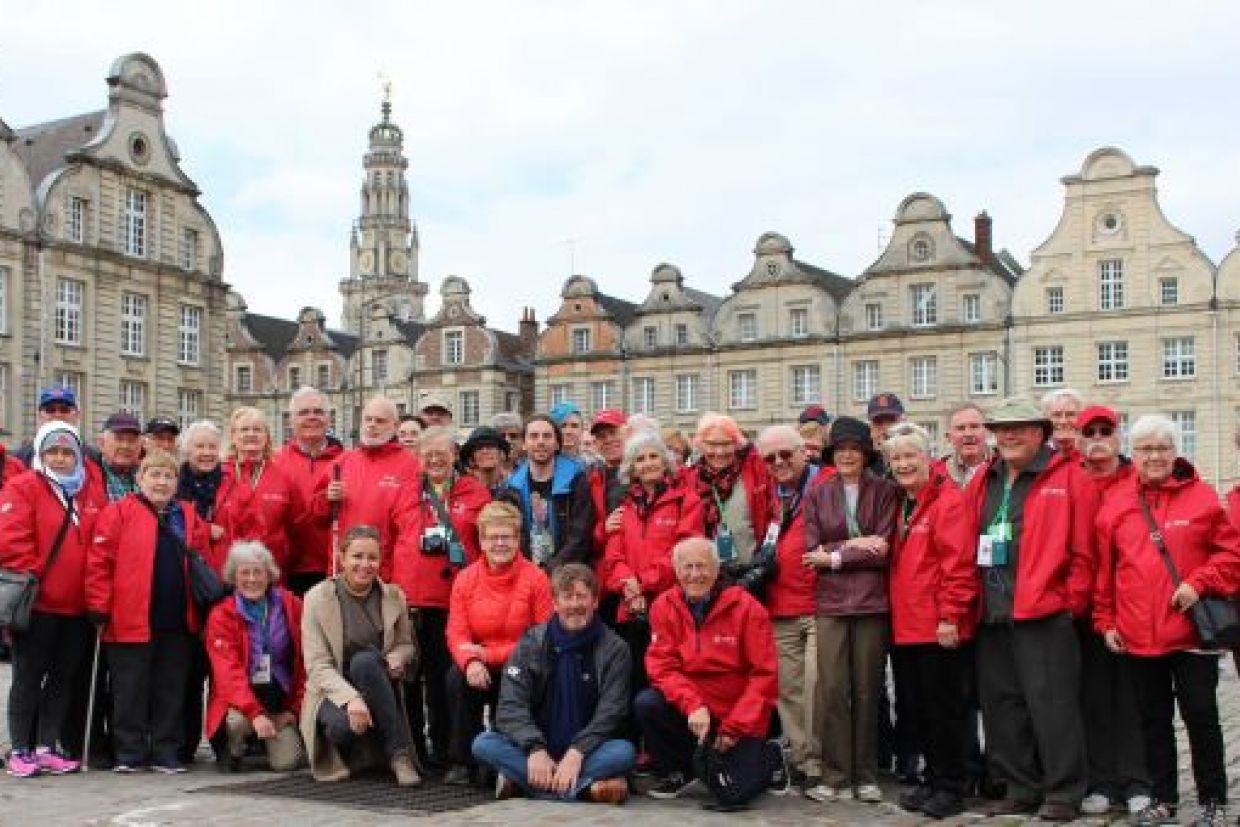There are few places which conjure Canadian pride and humility like the world war battlefields of northern France.
Queen’s Manager of Alumni Education and Travel, Melanie McEwen, Artsci’87, has taken part in a number of alumni tours to destinations all around the world, but none matched the emotional journey of the recent alumni trip to Vimy Ridge.
In April of this year, Ms. McEwen, along with 48 alumni travellers, was present for the celebration of the 100th anniversary of the Battle of Vimy Ridge as part of a 10-day alumni tour, Vimy Ridge Centennial: World War History in Europe. The tour started in Paris, and over the course of the week, the travellers journeyed from the French capital, along the Normandy coast, to Honfleur, Juno Beach, and Vimy Ridge.
The trip included visits to a number of Canadian war cemeteries and memorials. As a traveller and a former member of the Queen’s Board of Trustees, Paul Blanchard (Arts’70, Law’75) remarked, “We passed the time together as we walked around the graveyards. They are the most moving – the Canadian graveyards – because of the vast numbers of headstones for young Canadians who died in those two wars.” Many of the travellers had personal connections to soldiers and veterans, but as Mr. Blanchard further explained, “Each and every one of us was moved by how well preserved these memorials were. I think it was a tribute to those lives, to their sacrifices.”
Dr. Jean Hutchinson, Head of Queen’s Department of Geological Sciences and Geological Engineering, accompanied the trip as a Faculty Study Leader. A geological engineer might seem like an unconventional choice, but Dr. Hutchinson was part of a consultation team in the early 2000s that was involved in the Vimy Memorial restoration work. During the tour, she provided detailed insights into the geological aspects of the trenches built during the Western Front engagement. Dr. Hutchinson’s additional knowledge about the military strategy of the four Canadian divisions who fought at Vimy brought the geography of Vimy alive for the travellers. Much of the landscape around the memorial still bears the scars of that time. “Normally, you’d expect to get a historical perspective of the battles, but Dr. Hutchinson added wonderful background and side ground to everything we were seeing and feeling,” said Mr. Blanchard.
Along with trenches, both sides also dug tunnels out under No Man’s Land. As Dr. Hutchinson explained, “I think that people are surprised to learn how much geology affected almost everything that was done in the First World War. The way the lines were set up, how they used the terrain.” Both sides used military mining explosions to terrible effect. Tunneling under the opposing front’s lines in order to set off mines was a key tactic, and Dr. Hutchinson shared stories about the sappers who dug the tunnels and set the mines.
This was Dr. Hutchinson’s first time accompanying an alumni tour, and she acknowledged that she was grateful for the learning opportunities the trip provided her. “Some of the sites we visited I had no perspective, other than being an interested visitor. I didn’t have any technical expertise on them,” she said, “so, I benefitted tremendously from the tour guides and my fellow travellers.” Many of the tours’ participants had brought stories and questions to explore with their fellow travellers. On the bus journeys between destinations, the group would share additional materials or enjoy impromptu discussions and anecdotes with Dr. Hutchinson.
The core value of the alumni travel program is life-long learning -- a responsibility that Ms. McEwen takes very seriously. Before the tour left, she reached out to Veterans Affairs Canada who supplied a plethora of brochures and booklets about the world wars and Vimy Ridge specifically.
As part of every alumni tour, the alumni travel office provides participants with educational materials to enhance their appreciation for and understanding of their destination. Because of the alignment with the Vimy 100 celebrations, this tour presented additional learning opportunities. The Vimy trip package also included a special magazine produced by the Royal Canadian Legion which included battlefield maps of the region. Alumni travellers used the maps while visiting key sites to retrace the Allied Forces’ movements during key battles.
For Ms. McEwen, this kind of shared learning and camaraderie is the best part of the travel program. “I want people to feel like they are going back to class. The travel program strives to create experiences that are rich in detail and depth, and travellers are empowered to indulge their intellectual appetites, ” she said.
Between 1914 and 1918, Canada sent approximately 650,000 men and women to participate in the Great War, and more than 66,000 Canadians gave their lives in the effort. Many people have come to consider the Canadian victory at Vimy a defining moment in Canadian nationhood. The battle of Vimy Ridge lasted four days, and victory came at a heavy cost. Over 10,000 Canadian were killed or wounded, and German forces suffered 20,000 casualties.
In recognition of the sacrifices made by Canada during the First World War, France granted Canada 107 hectares of land at Vimy to build and maintain a memorial. The names of all soldiers killed in the war, with no known grave, are recorded around the base of the memorial.
The Queen’s University Archives maintains a detailed record of Queen’s contributions to the world wars. Learn more about the Queen’s Remembers project and visit the Archives’ online First World War Story Maps for biographical details and military records for Queen’s students who were killed in action.
For over 30 years, the Queen's Alumni Educational Travel program has provided Queen's alumni, family, and friends with unique educational travel experiences around the world and in our own backyard. Enjoy all the benefits of travel - and none of the hassles - with our fully escorted tours around the world. Learn more our current alumni tour offerings.


